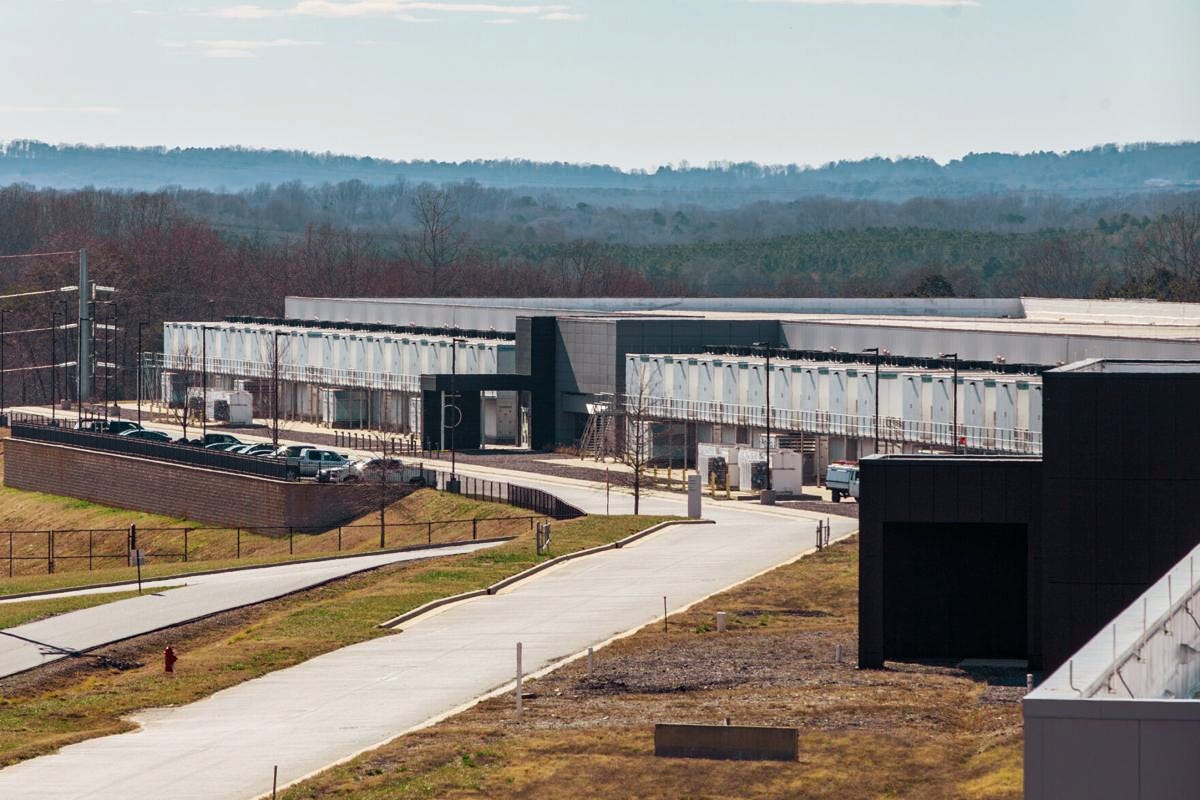North Carolina and Other States Are Turning AI Into Industrial Policy
Local resistance meets statewide ambition in the rush to build AI infrastructure

Following new federal support for AI industrial policy, states are beginning to chart their own paths to accelerate AI development and expand the energy infrastructure needed to sustain it. In the past year, states like Rhode Island, Virginia, and Washington have created task forces to explore AI’s role in government, while California launched a sweeping initiative to deploy generative AI in transportation and tax services. Mississippi ordered agencies to name AI coordinators and set standards for fairness and transparency, and Ohio is requiring every public school to adopt AI policies by 2026. Other states are still sorting out their approach—Colorado, for example, recently pushed back implementation of its AI Act until mid-2026.
I’m working on a broader review of these state-level initiatives, but a recent executive order in North Carolina offers an early glimpse of how these strategies are beginning taking shape. For further background, you can read my two-part series on federal AI industrial policy here:
Community resistance to data centers is colliding with state-level efforts to fast-track AI infrastructure.
In Tarboro, a small town of about 11,000 residents east of Raleigh, a five-hour public hearing earlier this month ended in an unusual decision. The town council voted 6–1 to block a proposed multibillion-dollar data center from regional developer Energy Storage Solutions. The project promised 500 jobs and $11 million in property taxes each year, but it also required enormous energy and water use—500,000 gallons of water a day, according to the developer—and would have transformed 52 acres into a hyperscale campus.
The opposition was vocal. Residents described the project as a threat to Tarboro’s character, environment, and household utility bills. More than 700 people signed a petition saying the facility would “dramatically alter” the community. Some council members admitted they didn’t have enough information to judge the proposal, while the mayor recused himself after acknowledging he couldn’t ignore the views of constituents.
Tarboro isn’t alone. Residents of Apex are fighting a rezoning request for 190 acres near the Shearon Harris Nuclear Plant. A 100MW natural-gas-powered campus was just rejected in another town. And in Mooresville, a $30 billion data center proposal was pulled after officials signaled they would not support it. Communities are repeatedly raising concerns about noise, appearance, energy strain, and modest job creation. Developers counter that data centers bring tax revenue, high-wage tech jobs, and a place in the digital economy.
While residents push back, industry groups and lawmakers are working to limit local control. In several states, legislatures have advanced preemption laws that curb municipal authority over zoning and permitting for data centers and energy projects. These measures shift power upward, weakening the ability of communities to shape decisions about land and resource use in their own backyards. In North Carolina, debate is underway on HB 1002, a bill that would prevent utilities from recovering the costs of grid upgrades for data centers through general ratepayer charges—that households could be left to subsidize the infrastructure needed for massive private facilities. This is something other states have also passed or are considering.
Against this backdrop of local resistance and legislative maneuvering, Governor Josh Stein issued Executive Order 24. The order recognizes that the rapid buildout of AI and data centers will require new substations, expanded water systems, and potentially higher costs for households if those expenses are spread through general rates. It situates AI governance not just in the realm of ethics and innovation but firmly within the contested politics of infrastructure and community control.
North Carolina is positioning itself as both builder and regulator of the AI economy.
On September 2, 2025, Governor Josh Stein signed Executive Order 24. The order creates three new structures meant to put North Carolina at the forefront of artificial intelligence.
First, there is the AI Leadership Council, a 25-member group that brings together state officials, lawmakers, company executives from firms like SAS, IBM, and Pryon, along with university researchers from UNC, Duke, and North Carolina Central. The council will advise on AI strategy, ethics, and workforce planning.
Second, the order sets up an AI Accelerator inside the Department of Information Technology. This office will define standards, set rules for data and intellectual property, and review pilot projects across state agencies.
Third, every cabinet agency now has to form its own AI Oversight Team and submit at least three potential AI use cases within 180 days. That means proposals for things like using AI to speed up licensing, screen eligibility for programs, or build digital assistants to guide residents through state services.
The order also ties AI planning directly to North Carolina’s Energy Policy Task Force. That’s because AI growth depends on expanding physical infrastructure. As I’ve covered extensively in Techno-Statecraft, Data centers and AI campuses use large amounts of electricity and water. Amazon has already announced a $10 billion AI campus in Richmond County, and Duke Energy has pointed to AI data centers as one of the biggest new demands on the grid.
The executive order does more than set ethical guidelines. In fact, its core aims are further afield from ethics. It positions the state as both promoter and regulator of AI infrastructure. From a critical political economy perspective, three dynamics stand out.
Market making by the state. By requiring every cabinet agency to submit pilot projects, the state manufactures demand for AI services inside government. This guarantees vendors proof-of-concept contracts and a steady pipeline of projects. With SAS, IBM, and Pryon executives seated on the Leadership Council, the same firms likely to benefit from these contracts are helping define the rules of engagement. This resembles earlier state-backed technology pushes, where public procurement created markets for private providers.
Utilities and cost allocation. Duke Energy and other utilities are central players in this story. Adding data centers means adding massive new electric loads. Utilities can either require companies like Amazon to finance their own infrastructure or socialize those costs across all ratepayers. Recent North Carolina rate cases and press coverage show watchdog groups already raising alarms about special tariffs for “big-user” loads. The executive order acknowledges the tension but routes responsibility to the Energy Policy Task Force, creating a separate forum where decisions about who pays will play out.
Universities and research pipelines. The Triangle’s universities gain formal roles in shaping standards and piloting projects. UNC has recently launched a School of Data Science and Society, Duke hosts AI and science-and-society initiatives, and North Carolina Central has created new AI institutes. The order positions them as intermediaries, producing research and talent to feed both public projects and private industry. Yet intellectual property and data ownership rules are centralized in the AI Accelerator, which could limit how much remains in public hands.
Workforce and communities. The council is tasked with tracking AI’s labor impacts and recommending retraining strategies. But the representation for labor, consumers, and local communities is pretty thin. There’s only one consumer seat, one workforce board seat, and one local government seat. Without bargaining mechanisms or enforceable obligations, workers are mainly asked to adapt through literacy programs rather than share in productivity gains. The push for corporate AI adoption in schooling is mirrored at the federal level.
Data center disputes expose the divide between corporate benefits and community risks.
The Tarboro fight shows what is at stake in NC and other parts of the U.S. While residents successfully mobilized to stop a $6.4 billion project they feared would disrupt their community, the company has already signaled it will sue to overturn the decision. In these hearings, councils will act more like courts, weighing expert testimony rather than public sentiment. That means local opposition often has limited legal standing.
At the same time, when the state positions itself as both promoter and regulator, it tilts the balance toward rapid adoption. That may help attract companies like Amazon and SAS, but it leaves communities like Tarboro to potentially absorb the consequences. The order’s references to energy and water impacts show that policymakers are aware of the stakes. Whether those concerns lead to real safeguards will depend on how the Energy Policy Task Force acts, how the Accelerator defines “high-risk” uses, and whether transparency mechanisms are enforced. But these things will likely depend on the balance of forces at play—who stands to benefit and who doesn’t, and more importantly, who has power and who doesn’t.
For big firms, the benefits are pretty clear. Amazon secures the infrastructure for its new campus. Duke Energy gains profitable new customers and justification for grid investments. SAS, IBM, and Pryon help shape the standards state agencies must adopt. Universities strengthen their research and training roles.
For residents, the picture is murky. Energy bills could rise if costs are shifted to ratepayers. There’s little sign of HB 1002 moving forward. Water and land use may also strain local resources and jobs may not match the scale of the promises. In these towns, people are learning that the legal system gives them few tools to stop projects once they are in motion.
The question is not only how artificial intelligence will be governed, but how the physical infrastructure that supports it will be built, financed, and distributed across the state. Executive Order 24 sets the rules for the AI economy. The community battles over data centers show how those rules will be tested on the ground.




